Guide to Choosing a Successful Speech Topic
January 05, 2018 - Dom Barnard
Choosing a speech topic can sometimes feel harder than giving the actual speech. We provide a simple framework for filtering down the number of possible topics to speak about.
When deciding on a speech or presentation topic, you might naturally want to talk about something you know very well. Although this is important, it’s only part of the equation when deciding on a suitable speech topic.
You need to ask yourself three questions about the topic, linking your expertise, passion and the audience.
Three questions to ask yourself
When deciding on a speech topic, ask yourself these three questions:
- How much do I know about the topic? Your audience needs to recognise you as a credible speaker and being knowledgeable about your topic is an easy way to do this. A good understanding will help you explain difficult parts of the topic and give you more confidence during the questions and answers session.
- Am I passionate about the topic? Your passion on the topic will affect all areas of your delivery, including body language, eye contact and energy levels. If you are interested in the topic, you’ll engage with the audience better and generally make for a more interesting speech.
- Will the audience be interested in the topic? If the audience doesn’t see how they can learn something useful from your topic, they’ll either not turn up or switch off early during the speech. Remember that your speech topic needs to contain value for the audience.
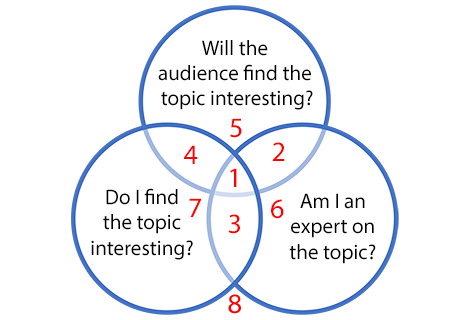
Write down a list of possible speech topics in line with the type of speech or presentation you are giving – is it a TED talk? A commencement speech? A conference presentation? A talk at your local club? Once you have this list, go through each of the three questions and put them into the segments of the Venn diagram above. Of course, the middle of the Venn diagram contains the topics you want to talk about.
What type of audience will you be speaking to?
In order to talk about a topic your audience care about, you’ll need to perform a quick analysis of your audience. There are several methods to do this, including:
- Find out if there are any other speakers and their topics if possible (if they are very technical, it give you an idea of the type of audience)
- Look at the event social media and read through previous comments
- Contact the event host to ask for more information about the types of audience that usually attend (for example, how many are international)
- Find out the size of the audience (this may determine the structure of your speech, including where to do the question and answer session, whether to include humour etc.)
There are a few audience characteristics which might determine the speech topic you select, including:
- Average age
- Gender (will it be a mostly female audience?)
- Ethnic background
- Types of career (is it a business focussed event?)
- Knowledge of the topic
Segment 1: Great speech topics
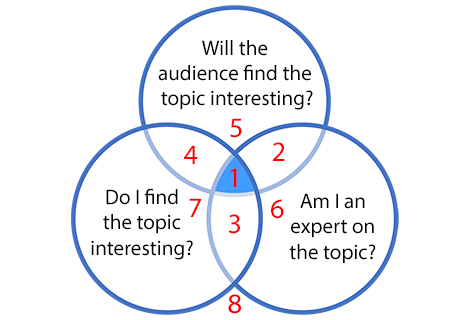
Topic segment: You are knowledgeable and passionate about the topic, and the audience is interested in it as well.
This is the perfect combination, and a good speaker draws speech topics from this segment all the time. Your knowledge of the topic assures that you’ll be confident. You enjoy talking about the topic so you’ll be passionate about it. On top of that, you have an enthusiastic, open audience.
When you end up speaking about topics in this segment, you’ll have a high chance of delivering a memorable and engaging speech.
Segment 2: Good content but lacking enthusiasm
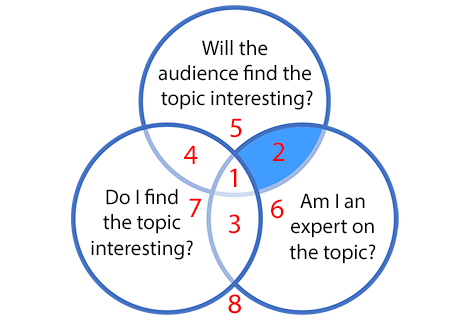
Topic segment: You know the topic well and your audience finds it interesting, however you lack enthusiasm for the topic.
Speeches in this segment will lack enthusiasm and might be delivered in a monotone voice with poor body language.
An example of a topic in this segment
When you finish a large body of research, for example towards the end of a PhD, you’ll usually have to present the results to an audience. The audience are usually invested in your topic and interested to hear about what you have to say. You also know plenty about the topic as you’ve spent years researching it.
How to make this a segment 1 topic
- Ask yourself what motivated you to learn about the topic in the first place. Try and find that enthusiasm again.
- You can try asking your potential audience what gets them excited about the topic. This might spark some interested in the topic again for you as you’ll understand the benefit you are giving the audience. You can also guide your presentation around the audience answers and you now know what they are excited by.
Segment 3: Great speech topics for a different audience
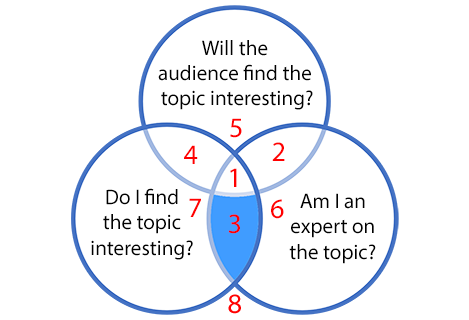
Topic segment: You know and find the speech topic interesting, however your audience does not.
An example of a topic in this segment
Perhaps you are the creator of an open source project for a new programming language. You may well love what you are developing and know everything about it. However if you are speaking at a local conference, the audience may not be as enthusiastic.
How to make this a segment 1 topic
- You’ve analysed your audience and find that the audience doesn’t care much for this topic. You need to understand how you can link the topic to something your audience will find interesting, through storytelling, metaphors, diagrams and any other suitable method.
- If you use body language and eye contact well, you might be able to engage the audience even if the topic isn’t of too much interest to them.
Tip
A topic in this segment is best saved for a different audience. If you find the right event and audience, this would a great topic to talk about and you’ll be both passionate and informed about the topic.
Segment 4: Interesting topics you know nothing about
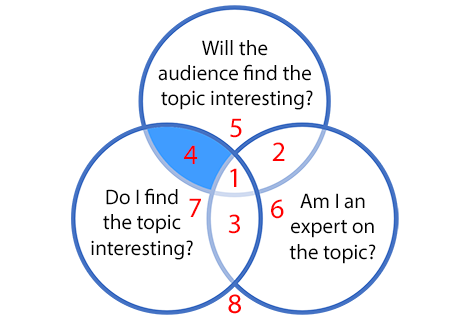
Topic segment: This is a topic both you and your audience find interesting, however your knowledge for the topic is lacking.
You may not know enough about the topic for you to appear credible in the eyes of the audience. Your lack of knowledge on the topic may get revealed in the questions and answers session after the speech.
An example of a topic in this segment
Imagine you’ve recently taken up a new hobby, impressionism painting, for example, and want to talk about tips for impressionist artists at a local gallery. You may love the topic and so will your audience, however as you’re new to the hobby, you won't have any expertise in it.
How to make this a segment 1 topic
This is one of the best segments to be in and there are a few approaches you can take to bring yourself into the middle segment:
- Build up your knowledge of the topic over time. If you have a big event such as a TED Talk coming up and a few weeks before you’re speaking, a topic in this segment could work well. Your passion and an engaged audience provide excellent motivation for your speech to succeed.
- If you’re speaking to a smaller group, you can try to facilitate a discussion between yourself and the audience members. You might start by giving a short speech which opens up some conversation points and then letting the audience discuss new ideas and solutions.
Segment 5: Speech topics someone else should deliver
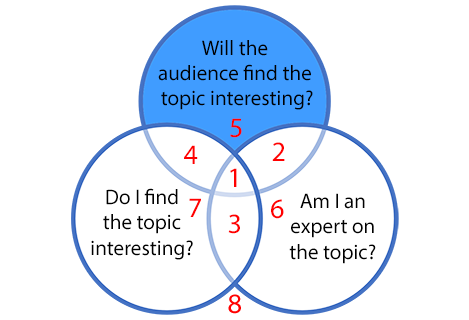
Topic segment: You audience care a lot about this topic, however you neither know or care about it.
How to make this a segment 1 topic
- This is a tough topic to bring into segment 1. You need to be passionate about the topic in order to learn about it. Sometimes when you start learning a topic, you’ll find yourself becoming more passionate the better you understand it. However this takes time and you’re better leaving this topic for someone else to deliver.
Tip
Don’t try to wing this topic. You’ll be shown up in the questions and answers session, as well as lack enthusiasm while delivering the speech. Your credibility will be ruined.
Segment 6: Topics you know but don’t interest you
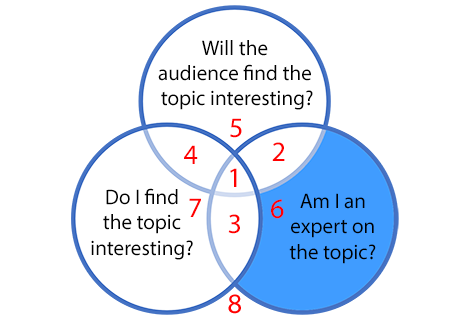
Topic segment: You know this topic well but neither you nor your audience find it interesting.
How to make this a segment 1 topic
- You can try to find your passion for the topic and link it to your audience’s interests. This is going to be difficult and you’ll be better off finding another topic.
Segment 7: Personal hobbies, not speech topics
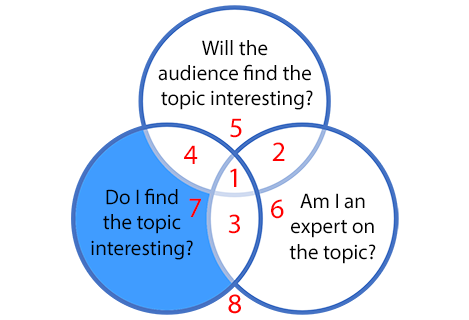
Topic segment: A speech topic you find interesting but don’t know much about and your audience doesn’t find it too interesting.
How to make this a segment 1 topic
- Of the three outer segments, this is the easiest to convert to a great speech topic. Having passion for a topic provides great motivation, and can motivate you to develop your own expertise, as well as seek out reasons why the audience should care.
Segment 8: Topics neither you nor your audience care about
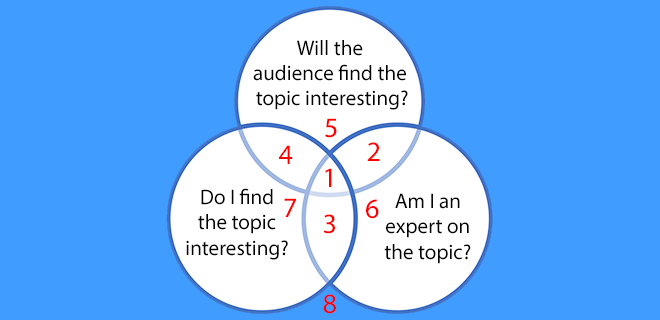
Topic segment: Disaster zone – you don’t know about the topic or care much about it, and neither does your audience.
How to make this a segment 1 topic
This would be very difficult. It’s best to choose another topic and not to waste your time on topics in this segment.
An example of a topic in this segment
Talks that fall into this dead segment are quite common. After taking a train the trainer course, you might be asked to coach other employees at your company which is mandatory for them to attend. You don’t know the topic very well, and it doesn’t excite you. Your audience’s attendance is mandatory, but they don’t really want to be there either.
To read more about these different segments, read The Secret of Choosing Successful Speech Topics.
Exercise for speech topic selection
Here’s a simple exercise to categorise your speech topics and get a better idea of how the Venn diagram works.
Start by brainstorming around 25 ideas for topics off the top of your head (use these 21 persuasive speech topics as a starting point). Give each of these a number for the segment on the Venn diagram by asking yourself the three questions.
How many are in the centre? Which are in two of three segments? Think about how or if you could get these into the centre segment. Perhaps if you’re not an expert on the topic, as we mentioned previously you could do additional research around it. Or if your audience doesn’t find the topic interesting, you could tweak it and come at it from a different angle, maybe adding in humour, to engage them better.


